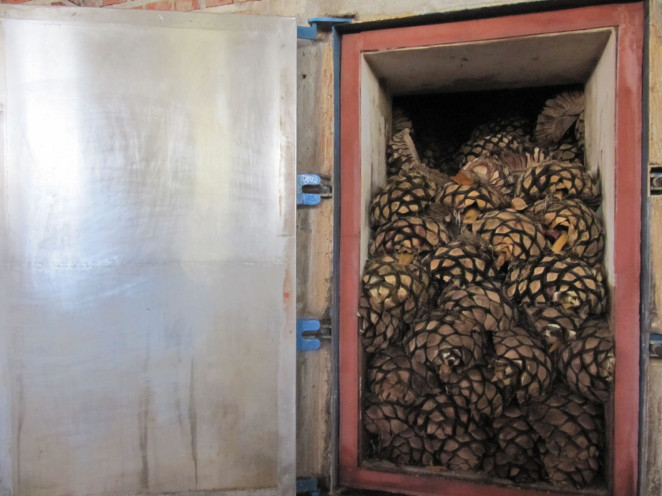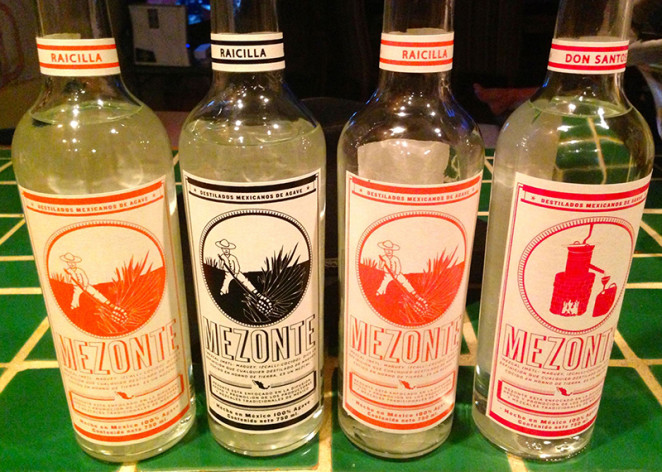We met David Suro in the lobby of our hotel in Guadalajara on a Sunday morning in December. We set out on a two-hour drive to the towns of Arandas and Atotonilco to meet some of the master distillers of the highlands region of Tequila. We were there in the midst of the twelve day Festival of the Virgin of Guadalupe, so street bands, fireworks, and church bells sounded throughout our travels.
Suro, President of the Tequila Interchange Project (TIP) and also the President of Siembra Azul Tequila, is an advocate for good clean and fair tequila and has his own brand of kosher tequila, Siembra Azul. Kosher because there is no organic certification of tequila in Mexico, and he wants to convey to the public the organic, sustainable methods he employs to make his tequila, and kosher certification gives some sense of that. Suro also owns Tequilas in Philadelphia, a Mexican restaurant with one of the deepest collections of tequila in the nation. David is one of the most knowledgeable people about tequila in the world and is a tequila activist. Here is some of what we talked about.

[symple_divider style=”solid” margin_top=”20px” margin_bottom=”20px”]
Davia Nelson: Tell me more about the Tequila Interchange Project.
David Suro: TIP is a group of bartenders, specialists, educators, researchers and tequila enthusiasts. We’re a non-profit organization and consumer advocacy group for agave distilled spirits. We get together and advocate the preservation of sustainable, traditional and quality practices in the industry of agave spirits. One of our main goals is to protect and promote the history and traditions of this spirit. We get involved in a lot of different areas of the agave distilled spirits – legislation, lobbying… But our favorite part is learning about the origins of this incredible Mexican spirit and seek to place a renewed emphasis on preserving the great heritage of agave distillation in Mexico.
DN: As we’re driving, I see corn fields all around us.
DS: In this area, you used to see only agave plantations. But as you can see, now there is a lot of corn, which is unusual for this region. I mean we are in the tequila territory but it looks like we’re in corn territory now. I feel like I’m in Arkansas. We’re surrounded by corn!
DN: So what’s going on here?
DS: The price of agave, just last year, was so low that there was no incentive for the agave farmers to plant agave. So with the lack of economical incentives, a lot of the farmers switched to other crops. It’s a vicious cycle. Now we see a shortage of agaves, but I’m pretty sure that by next year, we’re going to see a lot of these corn fields converted back into agave fields.
DN: Why was agave so low–I didn’t realize that agave was low last year when there’s such demand for tequila around the globe.
DS: It’s the price of agave. It reached its lowest price in history in the last couple of years— as low as 30 cents of a dollar per kilogram of agave. Now it’s bouncing up and we’ve already reached 6 pesos per kilogram of agave again but we’re starting to get into the dangerous territory for tequila production. It’s great for the farmers but it’s starting to be dangerous for small tequila producers. Look at this—you see nothing but cornfields.
And to make things even worse, it’s transgenic corn.
DN: Is Mexico trying to fight that?
DS: There’s a strong presence of Monsanto in this region. Even if we go back to agave, only God knows what is left on the soil after they’ve chemically treated the cornfields. We are starting to see the effects of the abuse of agrochemicals because the agave plants are getting weaker and weaker. 100% of the production—reproduction of agave is done now through cloning the plants. After doing this for so many generations we’re starting to notice that the agaves are getting weaker and the only way to protect them is by increasing the use of pesticides and herbicides. We’re playing against Mother Nature’s rules and you know what the consequences they are.




DN: There is a huge demand for tequila right now—why was the price so low?
DS: Because we plant more than we need and it’s a vicious cycle. The first agave crisis registered in history was back in 1919 when we had an epidemic of Spanish influenza and some doctors decided to prescribe the use of tequila to relieve symptoms. And then we had another crisis during the Second World War, when they were having a hard time bringing spirits from Europe to the United States and some of the distilleries in the United States had shut down or slowed production. There was a huge demand for tequila during that time. And again, you have to plan 7, 8, 12 years ahead.
The last crisis in 1998 was like a perfect storm. We had a snowstorm in this area that killed a lot of agaves. We also had a tremendous increase in demand for tequila, and an epidemic. So there was a shortage and that shortage was a signal for agave producers to start planting agaves, and we over did it. We planted millions of agaves.
DN: Let’s talk also about pre-Hispanic distillation, I know you are here to do some big research into the roots of agave distillation in Mexico.
DS: There are enough elements to make us believe that early cultures from Mesoamerica were doing distillation. The archeological facts indicate that it’s a very good possibility that distillation was part of their religious practices. So, what we are doing here is collecting samples and taking them back to the laboratory of the University of Pennsylvania to continue the research. Personally, with the elements that we have so far, I think there’s a very good chance that distillation was a practice of the individuals who lived in this region 3500 years ago.
DN: In the history books, where and when are they saying distillation came to Mexico?
DS: According to conventional history, distillation arrived to the Americas with the Spaniards and the Spaniards learned it from the Arabs. At the moment of contact with Europeans, Mesoamerican cultures started to take off from fermenting of agave beverages, into distilling them. I think that the theory of early distillation has more and more elements to make us believe that it was not the Spaniards, and that there was distillation happening in this part of the world pre-contact with Europeans.
DN: And when was distillation legalized for Mexican people?
DS: Well, the Spaniards had different regulations during the colonial times. They allowed indigenous people to consume alcoholic beverages but in the early 1600s it became a provision that alcoholic beverages could not be produced here in the Americas. We were their rivals so they decided to prohibit the production and consumption of local alcoholic beverages.
DN: And what are they finding in these sites that’s indicating possible distillation?
DS: One of the amazing things today was when we were able to literally hold the capatcha vessels. A capatcha vessel is an instrument made of clay, and they’ve already done a test on one and were able to obtain high proof that there was alcohol in it. These vessels were found in tombs that date back 3500 years. The interesting thing is—one of the reasons I believe it was used for early distillation, is that replicas of these vessels were used in China around the same period of time. But we have to do more tests to be 100% sure.

DN: Before we get to La Alteña Distillery and meet Carlos Camerena, let’s talk a bit about mezcal.
DS: Mezcal is the big brother of tequila. Not too long ago Mezcal was considered a second-class spirit and now this category is being recognized by the best palates in the world as one of the most complex and sophisticated spirits. It’s great to be part of this movement. Mezcal is fascinating because it’s become very attractive to investors but it’s also starting to pay the price of its success.
We just saw Bacardi, an incredible company that penetrates every single market in the world, put their eye on the category. We are very concerned about the implementation of mass distribution in a category that by nature is not capable to provide that. We usually don’t make comments individually, and I hope my colleagues in the Tequila Interchange Project excuse me, but I know that we all agree. The Tequila Interchange Project is totally against the way that Bacardi has been proposing their participation in the mescal category.
DN: What are they proposing?
DS: Bacardi is trying to teach artisanal producers how to make mezcal. I don’t think they’re in the position—in the historical, ethical, or moral position to consider that they can do a better job than people that have been doing this for thousands of years. That just shows you how little they know what the culture of mezcal is all about. Agaves take up to 35 years to mature! When you have master distillers or “palenqueros” that have been working for thousands of years, because the knowledge has been transmitted through generations, they know exactly what to do with the raw material.
The raw materials that are used to produce mezcal are mezcales or agaves, and very specific steps need to be taken in order to preserve their flavor. We don’t think that autoclaves and diffusers, the equipment used in the industrial production of tequila and mescal, can be used with this raw material. They’re working with a raw material that it takes a minimum of 8 years and up to 30 years to mature. No matter what they do now, they should have started working 8 years or even 30 years ago and I don’t think Bacardi’s been involved in the production of mescal for more than a year.
In mezcal we are allowed to use up to 27 different varieties of agaves and both the climate and the region where the agave grows is going to determine the amount of time it needs to reach maturity. Just yesterday at Pare de Sufrir, this incredible mezcal bar in Guadalajara, there was a mezcal in there made with 35 years old agaves. So, just by the nature of this spirit, it’s impossible to talk in industrial terms.



